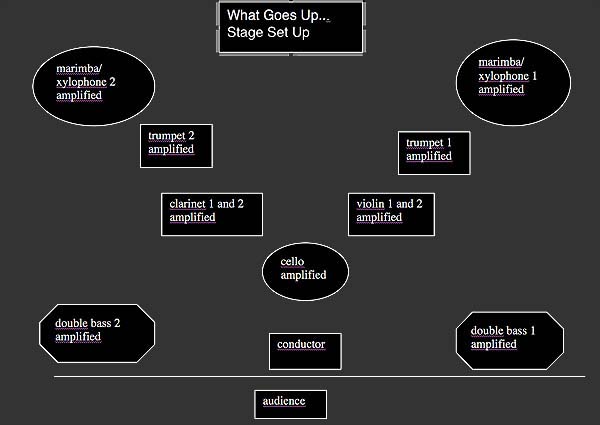 |
|
What Goes Up... was written for the Tanglewood Music Center and was commissioned by the Fromm Music Foundation at Harvard University in 1993. The piece is composed for eleven amplified instruments consisting of five spatially separated instrumental pairs framing a lone cellist. A musical voyage, What Goes Up... navigates an eclectic series of rising and compressing passages that lead to an anti-climax at the center of the work followed by a lengthy descent and slow release. The second half of the work is a musical palindrome where each section of the previous music is recast in the form of a surrealistic sonic landscape.
The disjointed musics found throughout the piece are balanced with a precise large-scale formal design. What Goes Up... is my telling of the great Western musical mess that took us through modernism and its reactions into and on to the far side of nowhere. That is the place my musical mind resides to this day, where I remain happily deluded that newly created music can be made and heard and shared without too much regard for the expanding global market economies.
Technical set-up for What Goes Up...
The equipment list:
11 microphones and xlr wiring, one for each instrument.
16 input/4 output mixer (mackie 1604 VLZ)
one stereo reverb unit (such as lexicon pcm90)
4 speakers with power and wiring
The composer will provide a Macintosh computer and a MOTU2408 analog/digital converter.
All the instruments must be amplified and fed into a mixer that will allow individual fader control for each microphone with a stereo send to a reverb unit and a stereo send to the audio interface of the Macintosh computer to be provided by the composer. This would be a 16 input mixer with 4 auxilliary sends such as the Mackie 1604VLZ. It is desired to have at least 4 outputs to 4 separate speakers on the stage. A stereo only output is possible but will diminish the effectiveness of the electro-acoustic processing. The instruments should be placed as far apart as possible on the stage in the configuration shown in the diagram. The four speakers should be integrated in some way with the instrumentalists so as to create the illussion of one unified sound. The speakers should not be suspended above the ensemble or placed too far to the front of the stage.
